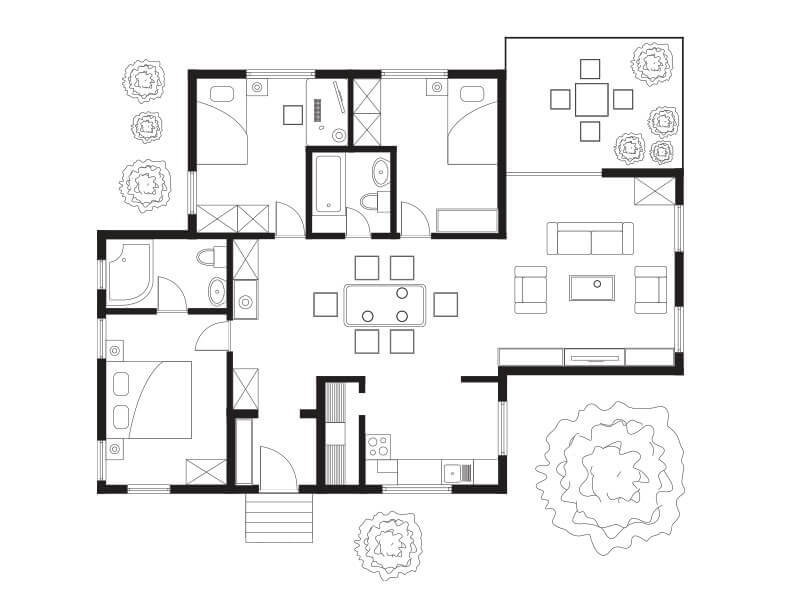Every day, we face a new topic amid the storm of hype. The latest is better than the previous. At least that is how it often feels if you listen to the buzz on the internet and the discussions of front runners. So much of bombarding leaves us with confusion and lack of clarity. I get it! The discussion is progressing at a speed that is sometimes difficult to follow. I see people applying for expert jobs but failing to explain fundamentals. Let’s explore one area together – compute services from the Cloud.
Let’s look at a comparison of virtual machines, containers and serverless computing in layman’s language.
The home you buy
A virtual machine can be compared to the home you buy (not build!). It is already there and sitting on a ground (HW, Host OS, Hypervisor). But it is empty, there is no furniture and you even have the possibility to change some of the interior walls (Guest OS Image).

It is fully yours and you pay for it independent of the load. You can scale within your house, let’s say you are getting kids, but there is a limit to it. When you reach that limit you will go for a bigger house. This is the reason why –
a) the houses are usually sized beyond the need and
b) scaling is time consuming (you are moving to a new house)
In addition, maintenance and cleaning is your job. Getting the heater maintained (or the versions up to date in your image) is a cost and effort on your bill as is the risk if you choose not to do it.
The furnished apartment you rent
You want less effort around the house and more focus, let us say on living. Your option is to go for a furnished apartment which is the comparable model to the container in IT.
It is already there, and you rent it for the time you want to use it. The rent while independent of the amount of usage (nights and weekends or full time with home office) gives you at least more flexibility should you have the need for change. The furniture is in place and you need not to worry about it (standardized environment).

If you want to scale, you can rent identical apartments in the same block. That is quick and easy.
Using purpose-built locations
For a furnished apartment, you pay as long as you rent it, independent of the usage. But fora purpose-built location, you will have to pay only while you use it. Would you buy a space for permanent use or on rental basis (furnished apartment) for the full month if you only need the space for a few hours for an event? Purpose-built locations are being used while you need them and only a pay-per-use system can be followed. If you need more, you use more and pay for more, but that additional space is not permanently or temporarily bound to you after its intended usage.

The advantage is that you only have to pay for the real usage. You can even tie this into volumes, e.g. number of guests in case of an event location. Even if you do not have the choice in designing the space to your needs, you can choose from the different locations available in the market.
In the same way, serverless offers you a range of services or functions which allows you to run your code without having to worry about servers and the bill will only ever show the time and volume you used the service.
Conclusion – The biker party
Just the way different solutions are available for space needs, solutions and services are available for server needs too. You may not want to host a biker party at your house but be renting an apt location may be a better option.

In the same way, not all applications benefit from serverless or containers. There are specific categories of applications that fit specific compute service models better than others. Here are some examples from a container consideration (extract):
- COTS Applications – Not recommended to containerize until supported by the COTS vendor
- Desktop Applications – Not recommended for containerization
- Windows Services – Containerization possible but will require code refactoring
- Console Applications – Good candidate for containerization
- WCF Services – Good candidate for containerization
- ASP.net Framework Applications – Good candidate for containerization

You can avoid most pitfalls by using automation and working with a partner that understands the technology, the enterprise needs and cultural tendencies within your organization. Some of your teams might want to rush ahead while others object the change completely.
Here are 5 takeaways with regards to Virtual Machines, Containers and Serverless Computing:
- The differences of the services are in the
- Level of customization possible
- Maintenance accountability
- Commercial commitment
- Scaling approach
- Each service caters to a specific kind of use – no service alone can cater to all usage scenarios
- The users (as in developers or projects) do need guardrails for when to use which service type
- The successful implementation of all service types is more than just technology
- Automation and the right partner will help you to avoid pitfalls
In case you are looking for the respective offerings, here are the names and links for the key players.
Microsoft:
Virtual machines: Azure Cloud Compute
Container: Azure Container / AKS Azure Kubernetes Service
Serverless Computing: Azure Functions
AWS:
Virtual machines: AWS Compute
Container: Containers on AWS
Serverless Computing: Lambda
GCP
Virtual machines: Compute Engine
Container: Containers on Compute / Kubernetes Engine
Serverless Computing: Cloud Functions



















